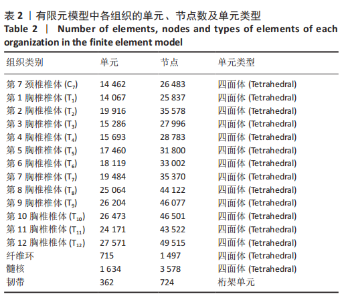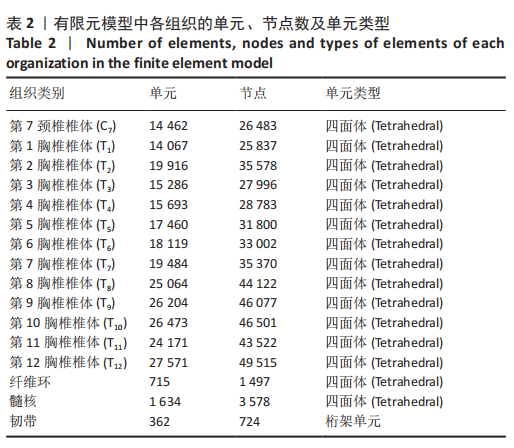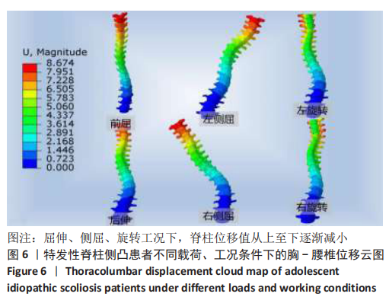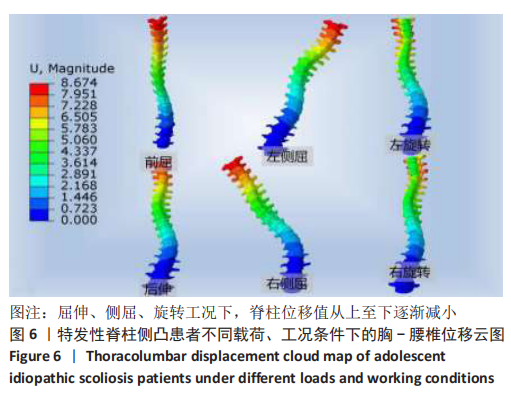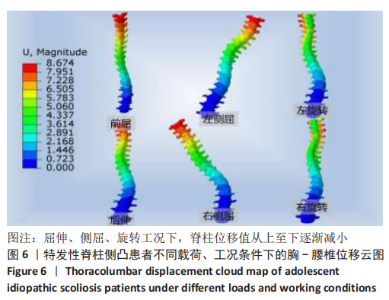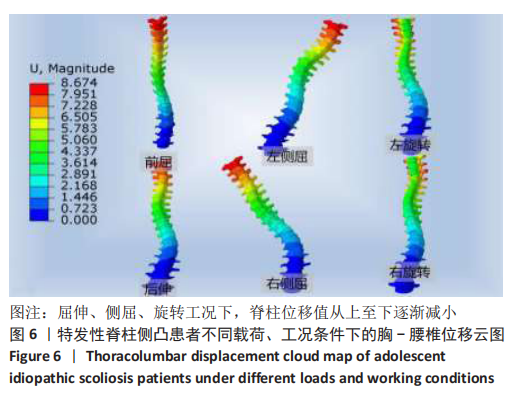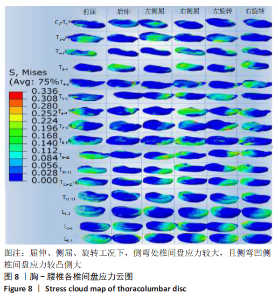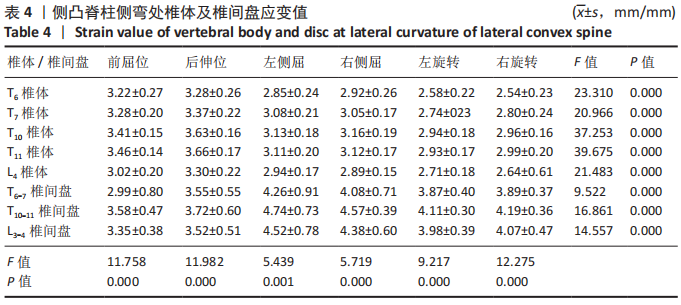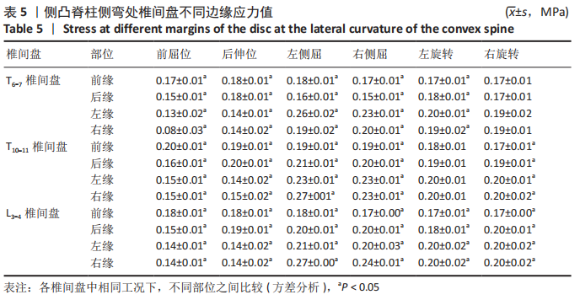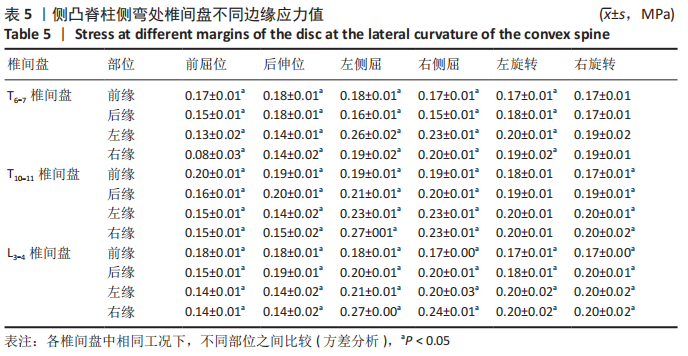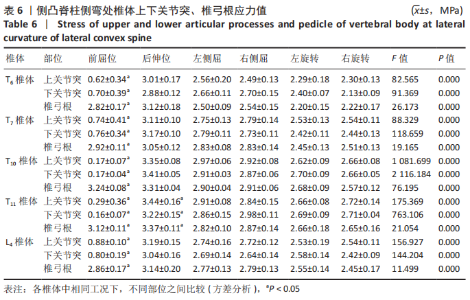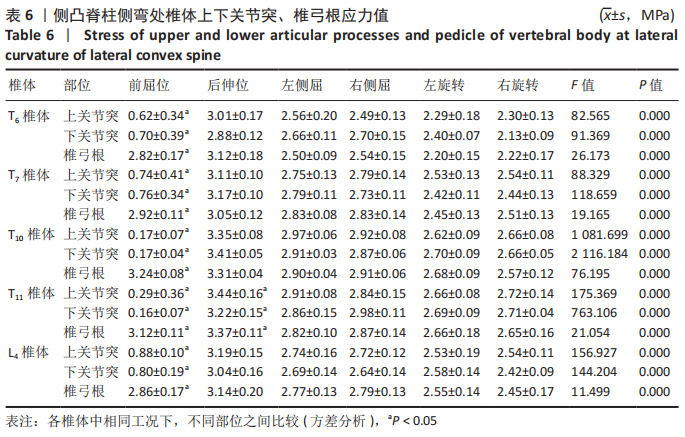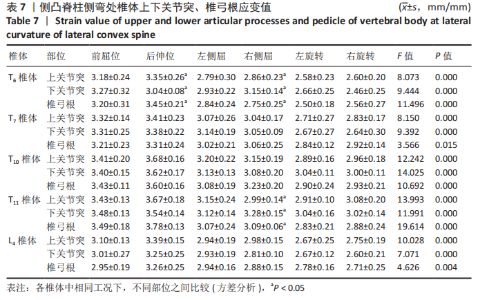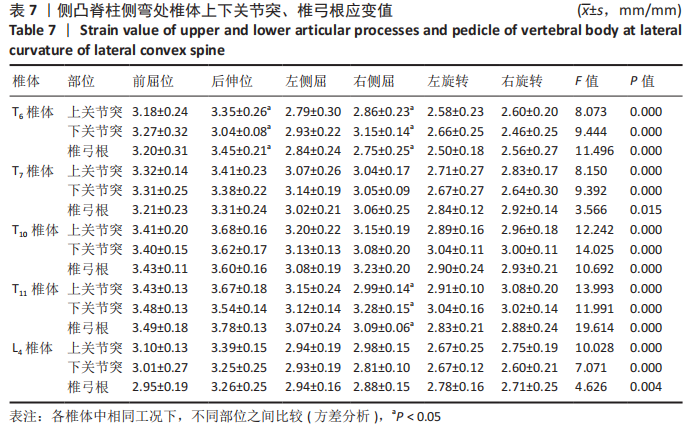Chinese Journal of Tissue Engineering Research ›› 2021, Vol. 25 ›› Issue (33): 5273-5280.doi: 10.12307/2021.313
Previous Articles Next Articles
Finite element analysis of stress and displacement of Lenke 3 adolescent idiopathic scoliosis thoracolumbar spine
Wu Chao1, 2, Gao Mingjie1, Wang Jianzhong3, Zhang Yunfeng4, Yu Jinghong4, Cai Yongqiang3, Wang Haiyan3, He Yujie3, Tong Ling1, Li Jiawei1, Gao Shang3, Wang Xing3, Wu Min5, Li Zhijun3, Li Xiaohe3
- 1Graduate School, 3Department of Human Anatomy, Inner Mongolia Medical University, Inner Mongolia Autonomous Region, China; 2Department of Radiology, Baotou Central Hospital, Baotou 014040, Inner Mongolia Autonomous Region, China; 4Department of Imaging, Second Affiliated Hospital of Inner Mongolia Medical University, Inner Mongolia Autonomous Region, China; 5Department of Orthopedics, First Affiliated Hospital of Baotou Medical College, Inner Mongolia Autonomous Region, China
-
Received:2020-11-16Revised:2020-11-19Accepted:2021-02-10Online:2021-11-28Published:2021-08-02 -
Contact:Li Xiaohe, MD, Professor, Master’s supervisor, Department of Human Anatomy, Inner Mongolia Medical University, Hohhot 010000, Inner Mongolia Autonomous Region, China Li Zhijun, Professor, Doctoral supervisor, Department of Human Anatomy, Inner Mongolia Medical University, Hohhot 010000, Inner Mongolia Autonomous Region, China -
About author:Wu Chao, Master candidate, Attending physician, Graduate School, Inner Mongolia Medical University, Hohhot 010000, Inner Mongolia Autonomous Region, China; Department of Radiology, Baotou Central Hospital, Baotou 014040, Inner Mongolia Autonomous Region, China Zhang Yunfeng, Associate chief physician, Department of Imaging, Second Affiliated Hospital of Inner Mongolia Medical University, Hohhot 010011, Inner Mongolia Autonomous Region, China -
Supported by:National Natural Science Foundation of China, No. 81460330 (to LXH); Natural Science Foundation of Inner Mongolia Autonomous Region, No. 2020MS08124, 2016MS08131 (to LXH); Youth Science and Technology Excellence Project of Education Department of Inner Mongolia Autonomous Region, No. njyt-15-b05 (to LXH); the Science and Technology Project of Inner Mongolia Autonomous region, No. 2016 (to LXH), No. 2019GG115 (to LZJ); 2020 Inner Mongolia Autonomous Region “Prairie Talent” Project for Youth Innovation and Entrepreneurship (to LXH); the Science and Technology Million Project of Inner Mongolia Medical University, No. YKD2017KJBW012 (to WHY)
CLC Number:
Cite this article
Wu Chao, Gao Mingjie, Wang Jianzhong, Zhang Yunfeng, Yu Jinghong, Cai Yongqiang, Wang Haiyan, He Yujie, Tong Ling, Li Jiawei, Gao Shang, Wang Xing, Wu Min, Li Zhijun, Li Xiaohe. Finite element analysis of stress and displacement of Lenke 3 adolescent idiopathic scoliosis thoracolumbar spine[J]. Chinese Journal of Tissue Engineering Research, 2021, 25(33): 5273-5280.
share this article
Add to citation manager EndNote|Reference Manager|ProCite|BibTeX|RefWorks

2.2 有限元实验模型的验证 此次研究模型在前屈、后伸、左右侧屈、左右旋转作用下的平均刚度值与以往文献报道中的平均刚度值基本吻合[11-12],并且做了几何形态相似性模型验证,将优化后的模型与临床站立位X射线片相对比,测量胸弯、腰弯的Cobb角及诸椎体中心到骶骨中垂线的垂直距离,测量结果差异性在实验要求范围内,因此所建三维有限元模型是有效的,可以用于临床研究。 2.3 AIS患者胸-腰段模型应力云图、位移云图变化 此研究模型发现,AIS胸-腰段脊柱模型在前屈后伸、左右侧屈、左右旋转情况下,侧弯明显处及胸-腰弯交界段、腰椎段椎体、椎间盘应力较大,见图5。脊柱椎体从上至下(C7-L5)位移值逐渐减小,见图6。"
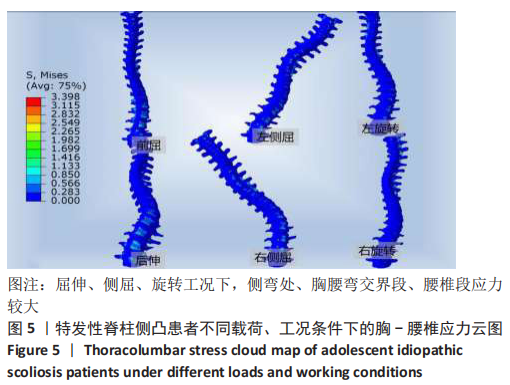
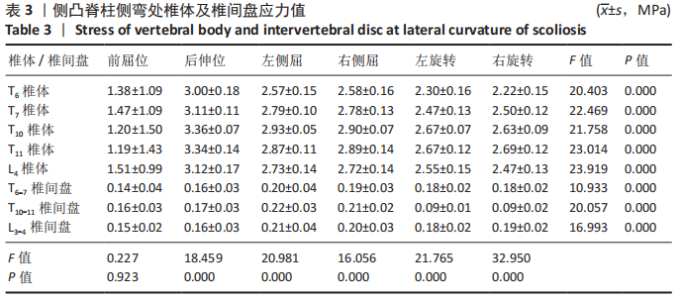
2.5 胸-腰椎重建模型侧弯处椎体、椎间盘的应力值、应变值变化 见表3-7及图7,8。 侧弯处椎体及椎间盘在6种不同工况条件下的应力值、应变值比较差异存在显著性意义(P < 0.05),多组之间比较发现T6、T7、T10、T11、L4椎体后伸位应力值最大,前屈位椎弓根应力值明显大于上下关节突应力值;前屈位T7、L4椎体应力较大,后伸、侧屈、旋转位T10、T11椎体应力值较大,T11椎体后伸位上关节突应力值明显大于下关节突及椎弓根,椎体应力值明显大于椎间盘应力值,见表3,6及图7。 多组之间比较发现T7、T10、T11、L4椎体后伸位应变值最大,T6椎体上关节突及椎弓根在后伸位应变值最大,下关节突在前屈位应变值最大,T10、T11椎体屈伸、侧屈、旋转位应变值较大,椎间盘应变值相对椎体应变值略大,见表4,7及图8。T6-7、T10-11、L3-4椎间盘各缘应力值、应变值在屈伸、侧屈、旋转之间差异有显著性意义(P < 0.05);T6-7、T10-11、L3-4椎间盘侧屈应力值较大,见表3,多组之间比较发现T10-11、L3-4屈伸位应变值较大;T6-7侧屈应变值较大,见表4。侧屈、旋转运动时,T6-7椎间盘左缘应力较大,T10-11、L3-4椎间盘右缘应力较大,且椎间盘变值大于椎体应变值,见表4,5。 "
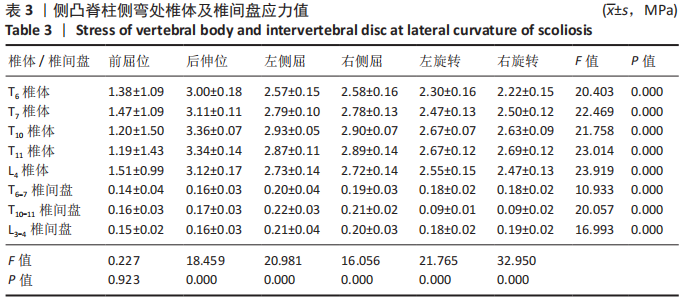
| [1] LEE CS, PARK SA, HWANG CJ, et al. A novel method of screw placement for extremely small thoracic pedicles in scoliosis. Spine. 2011;36(16): 324-327. [2] LO YF, HUANG YC. Bracing in adolescent idiopathic scoliosis. Hu Li Za Zhi. 2017;64(2):117-123. [3] 李明,倪春鸿,侯铁胜,等.TSRH系统后路矫正青少年特发性脊柱侧凸(附36例初步报告)[J]. 中国矫形外科杂志,2002,9(8):97-98. [4] HELENIUS I, REMES V, YQONEN T, et al. Harrington and Cottrel-Dubousset Instrume-ntation in adolescent idiopathic scoliosis. Long-term funcUonal and radiographic outcomes. J Bone Joint Surg Am. 2003;85-A(12):2303-2309. [5] LENKE LG, BETZ RR, HARMS J, et al. Adolescent idiopathic scoliosis: a new classification to determine extent of spinal arthrodesis. J Bone Joint Surg. 2001;83(8):1169-1181. [6] GOEL VK, MONROE BT, GILBERTSON LG, et al.Interlaminar shear stresses and laminae separation in a disc. Finite element analysis of the L3-L4 motion segment subjected to axial compressive loads. Spine (Phila Pa 1976). 1995;20(6):689-698. [7] STOKES IA, LAIBLE JP. Three-dimensional osseo-ligamentous model of the thorax representing initiation of scoliosis by asymmetric growth. J Biomech. 1990;23(6):589-595. [8] KIM HJ, CHUN HJ, KANG KT, et al. A validated finite element analysis of nerve root stress in degenerative lumbar scoliosis. Med Biol Eng Comput. 2009;47(6):599-605. [9] NIE WZ, YE M, LIU ZD, et al. The patient-specific brace design and biomechanical analysis of adolescent idiopathic scoliosis. J Biomech Eng. 2009;131(4):041007. [10] CHEN CS, CHENG CK, LIU CL, et al. Stress analysis of the disc adjacent to interbody fusion in lumbar spine. Med Eng Phys. 2001;23(7): 483-491. [11] 辛大奇,胡侦明,汉迪,等.Lenke3型成人特发性脊柱侧凸有限元模型的参数修正及有效性验证[J].中国组织工程研究,2017,21(31): 4975-4982. [12] HETH JA, HITCHON PW, GOEL VK, et al. A biomechanical comparison between anterior and transverse interbody fusion cages. Spine. 2001; 26(12):e261-e267. [13] BRAUN JT, OGILVIE JW, AKYUZ E, et al.Creation of an experimental idiopathic-type scoliosis in an immature goat model using a flexible posterior asymmetric tether. Spine(Phila Pa 1976). 2006;31(13): 1410-1414. [14] ROHLMANN A, ZANDER T, BURRA NK, et al. Flexible non-fusion scoliosis correction systems reduce intervertebral rotation less thanrigid implants and allow growth of the spine: a finite elementanalysis of different features of orthobioml J I. Eur Spine J. 2008;17(2):217-223. [15] WANG W, BARAN GR, BETZ RR, et al. The Use of Finite Element Models to Assist Understanding and Treatment For Scoliosis: AReview Paper. Spine Deform. 2014;2(1):10-27. [16] BELYTSCHKO T, KULAK RF, SCHULTZ AB, et al. Finite element stress analysis of an intervertebral disc. J Biomech. 1974;7(3):277-285. [17] VIVIANI GR, GHISTA DN, LOZADA PJ, et al. Biomechanicalanalysis and simulation of scoliosis surgical correction. Clin Orthop Relat Res. 1986; 208:40-47. [18] GIGNAC D, AUBIN CE, DANSEREAU J, et al. Optimization method for 3D bracing correction of scoliosis using a finite element model. Eur Spine J. 2000;9(3):185-190. [19] PERIE D, AUBIN CE, PETIT Y, et al. Personalized biomechanical simulations of orthotic treatment in idiopathic scoliosis. Clin Biomech (Bristol, Avon). 2004;19(2):190-195. [20] ZHANG H, HU X, WANG Y, et al. Use of finite element analysis of a Lenke type 5 adolescent idiopathic scoliosis case to assess possible surgical outcomes. Comput Aided Surg. 2013;18(3-4):84-92. [21] WANG L, ZHANG B, CHEN S, et al. A validated finite element analysis of facet joint stress in degenerative lumbar scoliosis. World Neurosurgery. 2016;95:126-133. [22] LI QY, ZHONG GB, LIU ZD, et al. Effect of asymmetric tension on biomechanics and metabolism of vertebral epiphyseal plate in a rodent model of scoliosis. Orthop Surg. 2017;9(3):311-318. [23] SCHLAGER B, NIEMEYER F, GALBUSERA F, et al. Asymmetrical intrapleural pressure distribution: a cause for scoliosis? A computational analysis. Eur J Appl Physiol. 2018;118(7):1315-1329. [24] MCAFEE PC, CUNNINGHAM B, MULLINEX K, et al. Middle-Column Gap Balancing and Middle-Column Mismatch in Spinal Reconstructive Surgery. Int J Spine Surg. 2018;12(2):160-171. [25] MCAFEE PC, EISERMAN L, CUNNINGHANM BW, et al. Middle column gap balancing to predict optimal anterior structural support and spinal height in spinal reconstructive surgery. Spine (Phila Pa 1976). 2017;42 Suppl 7:S19-S20. [26] SUGAYA T, SAKAMOTO M, NAKAZAWA R, et al. Relationship between spinal range of motion and trunk muscle activity during trunk rotation. J Phys Ther Sci. 2016;28(2):589-595. [27] 杨晓明, 顾苏熙, 李明, 等. 特发性脊柱侧凸椎体楔形变有限元模型分析[J]. 中国矫形外科杂志,2008,16(19):1493-1495. [28] 苏少亭, 苏少亭, 周红海, 等. 腰椎关节突关节的生物力学研究进展[J]. 中国脊柱脊髓杂志,2017,27(5):474-479. [29] YUENYONGVIWAT V, IAMTHANAPORN K, HARNROONGROJ T. Radiographic manifestation of hip dislocation after total hip arthroplasty. J Med Assoc Thai. 2014;97(1):60-63. [30] SHI D, WANGF, WANG D, et al. 3-D finite element analysis of the influence of synovial condition in sacroiliac joint on the load transmission in human pelvic system. Med Eng Phys. 2014;36(6): 745-753. [31] FAN W, GUO L. Finite element investigation of the effect of nucleus removal on vibration characteristics of the lumbar spine under a compressive follower preload. J Mech Behav Biomed Mater. 2017;78:342-351. [32] 庞胤,尹帅,赵长义,等.脊柱腰段三维有限元模型的构建与椎间盘应力分析[J].河北医科大学学报,2019,40(12):1368-1371. [33] FRANK P, CASTRO JR. Adolescent idiopathic scoliosis bracing and the Hueter-Volkmann principle. J Spine Journal. 2003;3(3):180-185. [34] ZADPOOR AA, WEINANS H. Patient-specific bone modeling and analysis: the role of integration and automation in clinical adoption. J Biomech. 2015;48(5):750-756. [35] NODA M, SAEQUSA Y, TAKAHASHI M, et al. Biomechanical study using the finite element method of internal fixation in Pauwels type vertical femoral neck fractrues. Arch Trauma Res. 2015;4(3): e23167. [36] LI J, ZHAO X, HU X, et al. A theoretical analysis and finite elementsimulation of fixator-bone system stiffness on healing progression. J Appl Biomater Funct Mater. 2018;16(3):115-125. [37] CHEUNG JPY, YIU KKL, VIDYADHARA S. Predictability of supine radiographs for determining in-brace correction for adolescent idiopathic scoliosis. Spine (Phila Pa 1976). 2018;43(14):971-976. [38] WANG Y, FEI Q,QIU G, et al. Anterior spinal fusion versus posterior spinal fusion for moderate Iumbar/thoracolumbar adolescent idiopathic scoliosis: a prospective study. Spine(Phila Pa 1976). 2008;33(20):2166-2172. (责任编辑:GD,ZN,ZH) |
| [1] | Xu Feng, Kang Hui, Wei Tanjun, Xi Jintao. Biomechanical analysis of different fixation methods of pedicle screws for thoracolumbar fracture [J]. Chinese Journal of Tissue Engineering Research, 2021, 25(9): 1313-1317. |
| [2] | Chen Xinmin, Li Wenbiao, Xiong Kaikai, Xiong Xiaoyan, Zheng Liqin, Li Musheng, Zheng Yongze, Lin Ziling. Type A3.3 femoral intertrochanteric fracture with augmented proximal femoral nail anti-rotation in the elderly: finite element analysis of the optimal amount of bone cement [J]. Chinese Journal of Tissue Engineering Research, 2021, 25(9): 1404-1409. |
| [3] | Zhou Jihui, Li Xinzhi, Zhou You, Huang Wei, Chen Wenyao. Multiple problems in the selection of implants for patellar fracture [J]. Chinese Journal of Tissue Engineering Research, 2021, 25(9): 1440-1445. |
| [4] | Xu Yulin, Shen Shi, Zhuo Naiqiang, Yang Huilin, Yang Chao, Li Yang, Zhao Heng, Zhao Lu. Biomechanical comparison of three different plate fixation methods for acetabular posterior column fractures in standing and sitting positions [J]. Chinese Journal of Tissue Engineering Research, 2021, 25(6): 826-830. |
| [5] | Cai Qunbin, Zou Xia, Hu Jiantao, Chen Xinmin, Zheng Liqin, Huang Peizhen, Lin Ziling, Jiang Ziwei. Relationship between tip-apex distance and stability of intertrochanteric femoral fractures with proximal femoral anti-rotation nail: a finite element analysis [J]. Chinese Journal of Tissue Engineering Research, 2021, 25(6): 831-836. |
| [6] | Song Chengjie, Chang Hengrui, Shi Mingxin, Meng Xianzhong. Research progress in biomechanical stability of lateral lumbar interbody fusion [J]. Chinese Journal of Tissue Engineering Research, 2021, 25(6): 923-928. |
| [7] | Xie Chongxin, Zhang Lei. Comparison of knee degeneration after anterior cruciate ligament reconstruction with or without remnant preservation [J]. Chinese Journal of Tissue Engineering Research, 2021, 25(5): 735-740. |
| [8] | Gu Jinshan, Yang Chaohui, Li Shuwei. Mechanical difference between anterior approach and anterior combined with posterior approach in the treatment of acetabular both-column fractures [J]. Chinese Journal of Tissue Engineering Research, 2021, 25(33): 5254-5258. |
| [9] | Xie Jiang, Guo Huili, Li Hui, Dai Jie, Zhu Xu. Finite element analysis of reconstruction of sagittal balance in ankylosing kyphosis with vertebral column resection [J]. Chinese Journal of Tissue Engineering Research, 2021, 25(33): 5259-5264. |
| [10] | Yu Yang, Xie Yizhou, Shi Yin, Wu Weidong, Gu Dangwei, Fan Xiaohong. Three-dimensional finite element analysis of the biomechanics of the posterior segment of lumbar facet arthroplasty with different sizes [J]. Chinese Journal of Tissue Engineering Research, 2021, 25(33): 5288-5293. |
| [11] | Zhu Feilong, Zhang Ming, Wu Yu, Wang Bin, Guo Xiaoqi, Cao Jiangang, Zhu Qian, Chen Wei. Foot posture and gait in adolescent idiopathic scoliosis patients: three-dimensional morphological analysis and biomechanics evaluation [J]. Chinese Journal of Tissue Engineering Research, 2021, 25(33): 5294-5300. |
| [12] | Hou Kunpeng, Zhao Quanlai, Wu Tianliang, Xiao Liang, Liu Chen, Xu Hongguang. Biomechanical stability of oblique lateral lumbar fusion and internal fixation [J]. Chinese Journal of Tissue Engineering Research, 2021, 25(33): 5362-5368. |
| [13] | Sun Yitong, Nie Weizhi. Biomechanical properties of fixation methods for clavicle fractures [J]. Chinese Journal of Tissue Engineering Research, 2021, 25(33): 5369-5373. |
| [14] | Lü Jie, Wang Yongfeng, Yuan Jie, Xu Zhaojian, Qin Yichuan, Hao Jiaqi. Biomechanical finite element analysis of lateral displacement of the cage after oblique lumbar interbody fusion [J]. Chinese Journal of Tissue Engineering Research, 2021, 25(33): 5301-5306. |
| [15] | Zhou Wenxing, Wang Lin . Effect of side cutting foot strike pattern and angle on the biomechanics of lower extremities [J]. Chinese Journal of Tissue Engineering Research, 2021, 25(32): 5184-5190. |
| Viewed | ||||||
|
Full text |
|
|||||
|
Abstract |
|
|||||
